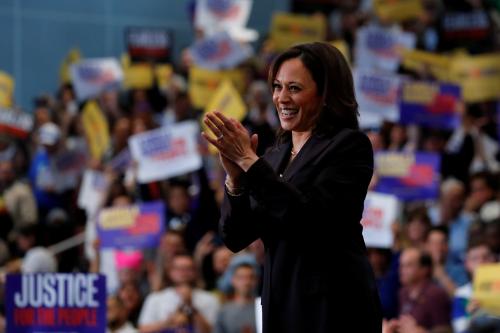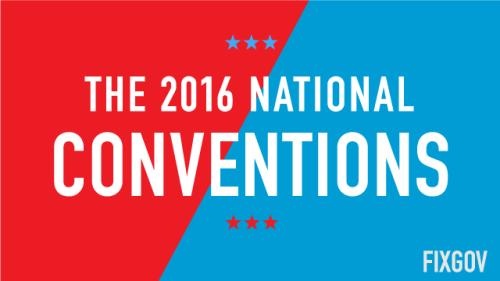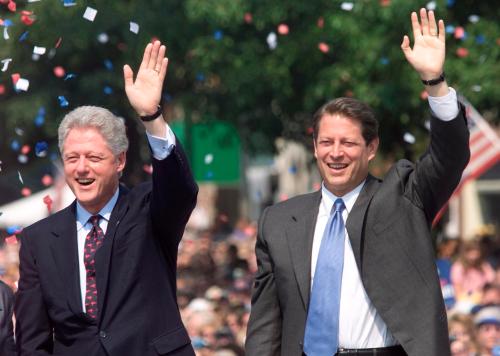On Tuesday, all eyes will be on Tim Kaine and Mike Pence as they square off in the vice presidential debate, each hoping to make the case that his running mate should be president of the United States and that he himself is prepared to be next-in-line for the highest office. Until recently, however, the vice presidency and the relationship between presidents and vice presidents was not of very much interest—and for good reason.
Historically, vice presidents have been understudies; often disliked or even despised by the president they served, used by political parties, derided by journalists, and ridiculed by the public. The job was so peripheral that vice presidents themselves often disparaged the office. Vice presidents were routinely cut out of the action of the White House, relegated to trivial chores, or dispatched to foreign countries to attend funerals or take part in other, largely ceremonial affairs. Harry Truman was kept so out of the loop that he didn’t even know about the project to build the atom bomb until President Roosevelt died and he became commander in chief.
As I explain in a new paper on the vice presidency, these distant relationships make perfect sense when you consider that from the beginning of the 19th century until the very end of the 20th century, most vice presidents were chosen to “balance” the ticket. Balancing the ticket meant choosing someone who was different from the president in some fundamental way, all but guaranteeing that the office of the vice president would be sidelined and the office holder not given much responsibility at all.
But that all changed when candidate Bill Clinton selected Senator Al Gore as his running mate in 1992. There wasn’t even a hint of balance about the Clinton/Gore ticket that sported two young, southern, ivy leaguers. To Clinton, reinforcing his message was more important than balancing his ticket. And according to election results in 1992 and ’96, his choice was a good one.
In his campaign and in his White House, Clinton embraced the idea of a partnership with his vice president. Al Gore was given unprecedented levels of responsibility and ownership over entire policy portfolios, from U.S.-Russian relations to the 1996 Telecommunications Act. Clinton and Gore didn’t just break the mold; they shattered it. And subsequent presidents and vice presidents have followed in their footsteps. It is not an exaggeration to say that Al Gore and his successor Dick Cheney probably exerted more influence on policy than all prior vice presidents combined. Today, Joe Biden enjoys similar levels of responsibility in the White House.
As Americans have become more accustomed to involved and competent vice presidents, election politics have changed. Ever since Clinton’s selection of Gore in 1992, the “balancing” model has proven unsuccessful in general elections. In 1996, Bob Dole put Congressman Jack Kemp on his ticket in an ideological balancing act. In 2004, John Kerry chose John Edwards, a Southerner with working class roots, to balance his New England upper crust upbringing. In 2008, John McCain’s choice of Sarah Palin was another failed ideological balancing act.
The winning candidates in each of those elections (as well as some losing candidates in races that featured two “partnership” tickets) have chosen to instead follow the collaborative model, thus giving way to a radically different relationship between modern presidents and vice presidents.
Though the notion of balance hasn’t entirely evaporated, both 2016 presidential candidates have selected running mates that represent partnership. The Republican nominee Donald Trump, a man with no government experience, chose Governor Mike Pence of Indiana, a man with twelve years of experience in Congress and the current governor of Indiana. Hillary Clinton chose Senator Tim Kaine whose long government resume includes stints as mayor of Richmond and lieutenant governor of Virginia. However, it should be said that the choice of Pence was seen by many as an olive branch to the conservative wing of the GOP, and the choice of Kaine may help Hillary’s chances of taking Virginia and perhaps one or two other Southern states that have been difficult wins for Democrats.
It is yet to be seen how voters will respond to the Clinton/Kaine and Trump/Pence tickets, but no matter the outcome of the election, the partnership model in the vice presidency is here to stay, and the office will continue to evolve into much more than it ever was. A Trump presidency has the potential to completely reshape the role of the vice president, should he turn out to be uninterested in the nitty gritty details of governing.
Elaine C. Kamarck is a Senior Fellow at the Brookings Institution and author of Primary Politics: Everything You Need to Know about How America Nominates Its Presidential Candidates. She is a superdelegate to the Democratic convention.







Commentary
How Kaine and Pence both fit the mold of a “modern vice president”
September 29, 2016